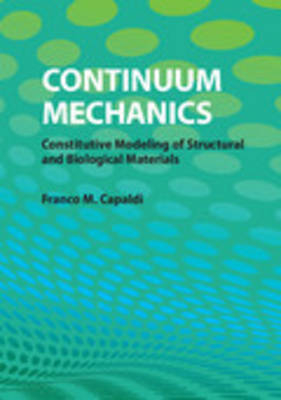
Continuum Mechanics
Constitutive Modeling of Structural and Biological Materials
Seiten
2012
Cambridge University Press (Verlag)
978-1-107-01181-6 (ISBN)
Cambridge University Press (Verlag)
978-1-107-01181-6 (ISBN)
This up-to-date textbook for courses in continuum mechanics provides both the theoretical framework and the numerical methods required to model the behaviour of continuous materials. This text is tailored for advanced undergraduate or first-year graduate students with numerous step-by-step derivations and worked-out examples.
This is a modern textbook for courses in continuum mechanics. It provides both the theoretical framework and the numerical methods required to model the behaviour of continuous materials. This self-contained textbook is tailored for advanced undergraduate or first-year graduate students with numerous step-by-step derivations and worked-out examples. The author presents both the general continuum theory and the mathematics needed to apply it in practice. The derivation of constitutive models for ideal gases, fluids, solids and biological materials, and the numerical methods required to solve the resulting differential equations, are also detailed. Specifically, the text presents the theory and numerical implementation for the finite difference and the finite element methods in the Matlab® programming language. It includes thirteen detailed Matlab® programs illustrating how constitutive models are used in practice.
This is a modern textbook for courses in continuum mechanics. It provides both the theoretical framework and the numerical methods required to model the behaviour of continuous materials. This self-contained textbook is tailored for advanced undergraduate or first-year graduate students with numerous step-by-step derivations and worked-out examples. The author presents both the general continuum theory and the mathematics needed to apply it in practice. The derivation of constitutive models for ideal gases, fluids, solids and biological materials, and the numerical methods required to solve the resulting differential equations, are also detailed. Specifically, the text presents the theory and numerical implementation for the finite difference and the finite element methods in the Matlab® programming language. It includes thirteen detailed Matlab® programs illustrating how constitutive models are used in practice.
Professor Franco M. Capaldi received his Ph.D. in Mechanical Engineering from the Massachusetts Institute of Technology. He worked at Sandia National Labs before joining the faculty at Drexel University. In 2006 he became an Associate Professor of Civil Engineering at Merrimack College. His research focuses on the modeling of biological and polymeric materials at various length scales.
1. Mathematics; 2. Kinematics; 3. The stress tensor; 4. Introduction to material modeling; 5. Ideal gas; 6. Fluids; 7. Elastic material models; 8. Continuum mixture theory; 9. Growth models; 10. Parameter estimation and curve fitting; 11. Finite element method; 12. Appendix.
| Zusatzinfo | 30 Tables, unspecified; 81 Line drawings, unspecified |
|---|---|
| Verlagsort | Cambridge |
| Sprache | englisch |
| Maße | 181 x 259 mm |
| Gewicht | 890 g |
| Themenwelt | Naturwissenschaften ► Physik / Astronomie ► Mechanik |
| Naturwissenschaften ► Physik / Astronomie ► Strömungsmechanik | |
| Technik ► Maschinenbau | |
| ISBN-10 | 1-107-01181-7 / 1107011817 |
| ISBN-13 | 978-1-107-01181-6 / 9781107011816 |
| Zustand | Neuware |
| Haben Sie eine Frage zum Produkt? |
Mehr entdecken
aus dem Bereich
aus dem Bereich
Statik - Kinematik - Kinetik - Schwingungen - Festigkeitslehre
Buch | Hardcover (2021)
Hanser, Carl (Verlag)
29,99 €


